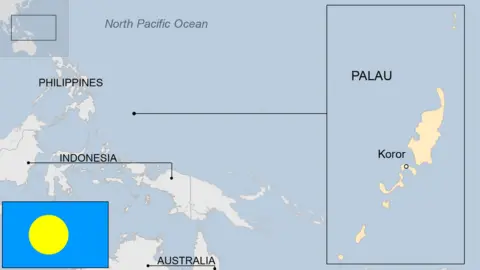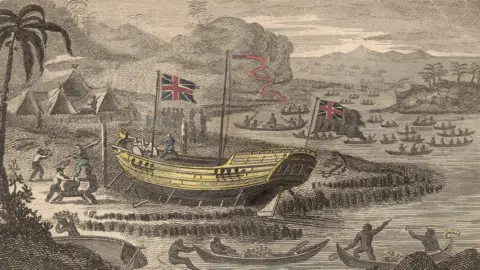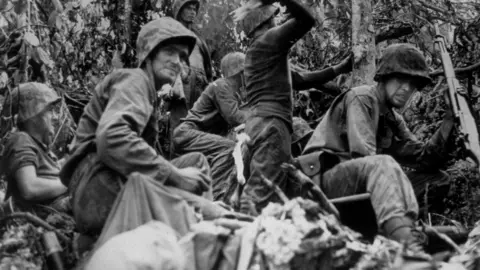Palau country profile
This page is no longer being updated. It was last updated on 12 November 2024
 BBC
BBCMore than 200 volcanic and coral islands, many of them surrounded by a single barrier reef, make up the northern Pacific nation of Palau.
Palau became independent in 1994, after being part of a United Nations trust territory administered by the US.
It relies on financial aid from the US, provided under a Compact of Free Association which gives the US responsibility for Palau's defence and the right to maintain military bases in the country.
Tourism accounts for around 40% of Palau's economy. Many visitors come from Taiwan, with which Palau has diplomatic ties. Taiwanese aid boosts the economy. The government is Palau's largest employer.
Monoliths and other relics are reminders of an ancient culture that thrived on the islands, and despite Western trappings many Palauans identify strongly with their traditions and rites.
Palau's recent history has been dominated by outside influences from Spain, Britain, Germany, Japan and the US. Palau saw some of the region's fiercest fighting in World War Two.
In 2006, a new Congress building was opened at Ngerulmud, which replaced the republic's largest settlement, Koror City, as the country's capital.
There is concern that the low-lying islands could be badly affected by rising sea levels possibly due to climate change.
- Read more country profiles - Profiles by BBC Monitoring
REPUBLIC OF PALAU: FACTS
- Capital: Ngerulmud
- Area: 459 sq km
- Population: 18,000
- Languages: Palauan, English, plus Japanese, Sonsorolese, Tobian
- Life expectancy: 69 years (men) 75 years (women)
LEADERS
President: Surangel Whipps Jr
 Getty Images
Getty ImagesSurangel Whipps Jr was re-elected president in November 2024, after defeating former incumbent Tommy Remengesau Jr.
Whipps won the vote with one of the biggest margins in Palau's electoral history, taking some 57.5% of the vote. Remengesau, his brother-in-law, got 41.3%.
Analysts say the outcome showed voters support Whipps' policy agenda, which includes tax reforms and deeper engagement with the United States.
Ahead of the election, Whipps said that US protection played a key role in safeguarding Palau's territorial integrity.
"Since Palau is small, having the protection of the United States is important because we see what's happening now in the South China Sea between the Philippines and China," he said.
MEDIA
 Getty Images
Getty ImagesThe law provides for a free press, and there are no reports of official curbs on internet access. However, news outlets often struggle financially.
Regional and international news services are also available.
- Read full media profile
TIMELINE
 Getty Images
Getty ImagesSome key events in Palau's history:
c. 2500BC - Palau's first inhabitants - thought to have come from present-day eastern Indonesia - settle in the islands. The early Palauans develop complex social systems, practice fishing and farming.
1783 - English captain Henry Wilson is shipwrecked on a reef and becomes the first Westerner to visit.
1885 - Spain asserts its claim to the islands, which it administers as part of the Philippines.
1899 - Spain sells Palau to Germany as part of German New Guinea in the German-Spanish Treaty. Germany begins to exploit the islands' resources using native labour. Phosphate is mined and coconut plantations are developed.
1914 - Shortly after the outbreak of World War One, Japan seizes the islands from Germany and annexes them.
1919 - Following World War One, the League of Nations formally places the islands under Japanese administration as part of its South Seas Mandate.
1939-45 - World War Two
1941-42 - Japan uses Palau as a base to support its invasion and conquest of the Philippines.
1944 - US forces retake the islands in a bitter campaign amid controversy over the island's negligible wartime strategic value and the high casualty rate, which exceeded that of all other amphibious operations during the Pacific fighting.
1947 - Palau becomes a United Nations Trust Territory under US administration.
1979 - While four UN Trust Territories join to form the Federated States of Micronesia, Palau and the Marshall Islands vote against the proposed constitution.
1981 - Republic of Palau comes into being, following the territory's adoption of a constitution.
1982 - Palau signs a Compact of Free Association with the US, gaining access to US aid in return for US military rights.
1994 - Palau becomes independent under the Compact of Free Association with the US. Palau receives financial and other aid from Washington, and the US retains responsibility for defence and the right to operate military bases. Palau joins the UN.
2022 - Palau agrees to host a sophisticated $100m US air force over-the-horizon radar station, which is due to be operational by 2026.
 Getty Images
Getty Images